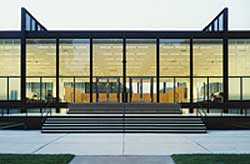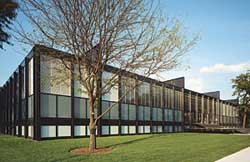The Perils of Restoring
Clune enlisted specialty-glazing contractor Harmon to handle the field work and endure the closest scrutiny. According to Harmon, the facade consists of more than 800 steel stops held in place by more than 6,250 screws, and each screw was countersunk to protect the ever-so-slightly beveled profile. Tenuta marvels at the scrutiny. They had to be submitted for approval, were rejected, remade, and resubmitted. Even the depth of the countersink was debated, until a tolerance of a mere 1¼64 inch was agreed upon.
The 120 lower lites were replaced with a clear tempered glass from Viracon, and the inner face was sandblasted to recreate the exact same effect as the original. The Miesian scholars were in agreement with this solution. However, Sexton knew that unless the sandblasted side was treated, the school would face the same staining and scratching problems it did before. Fortunately, technology eliminated many concerns. Computer-controlled manufacturing allows glass to be both tempered and sandblasted, and as proved here, to be protected by the application of three layers of ultra-clear epoxy, which has no reflectivity, will not change character, and will never yellow.
|
Finally, there was the issue of the paint. The sharp "Mies black" had faded to a dull gray. The original paint could not be used again, because it was lead-based. Product research led the architects to Tnemec, an industrial paint and coatings manufacturer known for products of extreme durability. The three coats that were applied should last about 25 years.
Studying Krueck & Sexton's restoration and renovation of Crown Hall reveals more about Mies's design methodology than a slide-show lecture in architecture school ever could. Its work also makes a convincing argument for balancing preservation of original intent with current needs. The great Modernist buildings of the 20th century were meant to have long, working lives. Modifications to Crown Hall will be necessary again in another 50 years. As evidenced by SOM's restoration of Lever House in New York in 2002 and Polshek and Partners' careful restoration of Louis Kahn's Yale Art Gallery in New Haven, currently under way, intimate intervention of Modernist icons might be the only authentic way to know them.










